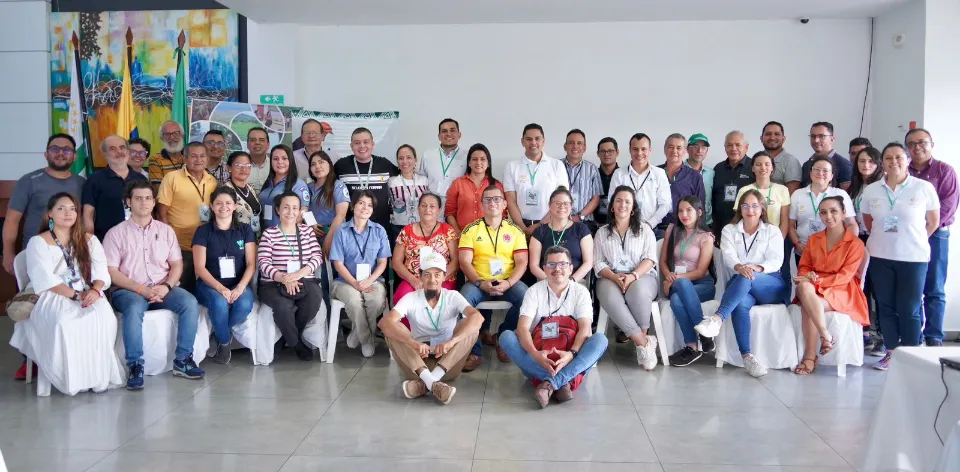 12/07/2024
12/07/2024
Colombia Plans the Countryside: Amazon Region

More than 30 entities, organizations, and associations from national and regional levels gathered in Florencia, Caquetá, to collectively build inputs for territorial planning and rural agricultural planning.
The agricultural frontier of the Amazon region amounts to 8,188,332 hectares, which is equivalent to 16% of the region; of that area, 66% (5,371,358 hectares) corresponds to conditioned agricultural frontier.
Bogotá, D. C., (@UPRAColombia, @claudialili76). On July 10th and 11th, the technical workshop "Colombia Plans the Countryside: Amazon Region" was held in Florencia (Caquetá), led by the Rural Agricultural Planning Unit (UPRA). The workshop included representatives from producer organizations, NGOs, Agriculture and Environment Secretariats from the departments of Guaviare, Amazonas, Caquetá, and Vaupés, the Ministry of Agriculture and Rural Development, the Ministry of Environment and Sustainable Development, regional environmental authorities, National Natural Parks, research institutes, academia, media, and others.
"The main objective of the workshop was to socialize the instruments of the national agricultural frontier, zoning of aptitude, and the institutional offer, so that rural agricultural planning and territorial planning are harmonized in the territorial planning, achieving coordination for informed decision-making. This is a work done with, from, and for the regions," said the director of UPRA, Claudia Liliana Cortés.
“It is of great importance that they invite the communities, listen to us, and make us part of these decisions since we know our land, we can contribute with our practices and proposals to cultivate without harming the environment, and also how to extract, show, and sell our products to improve the lives of all Amazonia inhabitants,” explained Cielo María Aya, representative of the Association of Displaced Persons of Caquetá, Asdeca.
In turn, Adriana Pérez, technical advisor of UPRA, explained: "With the development of this workshop, we seek to articulate actions and optimize efforts made in the territory, around rural agricultural planning and territorial planning. We have toured the country and already developed technical workshops in the Caribbean and Pacific regions; this week, collective construction will take place from the Amazon."
On the other hand, the Secretary of Environment and Agriculture of Caquetá, Juan Pablo Jaramillo, expressed: "We support the initiative of the technical table of Colombia plans the countryside, Amazon region, to know in detail where we should direct efforts concerning the agricultural frontier and zoning of aptitude and planning of rurality in our territory. The department of Caquetá needs investment, and it must be planned towards the growth of our countryside and rurality."
Likewise, Fredy Eduardo Lavao Uribe, Secretary of Agriculture and Productive Development of Vaupés, stated: "The importance of the event is reflected in the articulation of departmental entities with UPRA, for the updating of the Territorial Planning Plan (POT) and the Territorial Ordering Schemes (EOT) for the department of Vaupés and the definition of the agricultural frontier. Working together is the key for the Amazon region."
This workshop also sought to promote and encourage the sustainable and regulated use of the forest through the management of information from different institutions, allowing progress in the analysis of the forest component, with greater emphasis on non-timber forest products and agroforestry productive arrangements with peasant, black, and indigenous communities.
The agenda also included, as part of the fulfillment of point 1.1.10 of the Peace Agreement, the socialization of the Environmental Zoning Plan, adopted by Resolution 1608 of 2021, by the Ministry of Environment and Sustainable Development.
Points of interest:
- Colombia has a national agricultural frontier of 42,944,940 ha, 37.6% of the national continental territory, where agricultural activities are allowed and promoted; areas where, for legal, political, and technical reasons, they are restricted are recognized.
- Of the agricultural frontier, 22,803,490 ha (53%) are conditioned; in these areas, agricultural activities may be allowed, restricted, or prohibited according to the conditions imposed by law.
- The agricultural frontier of the Amazon region amounts to 8,188,332 hectares, which is equivalent to 16% of the region. Of this area, 66% (5,371,358 ha) are conditioned areas.
[1] * Departaments: Amazonas, Caquetá, Guaviare, Putumayo, Guainía, Vaupés y Vichada
[2] * Departaments: Amazonas, Caquetá, Guaviare, Putumayo, Guainía, Vaupés y Vichada.

